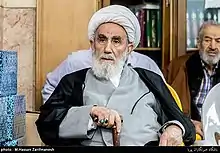Ali Orumian
Sheikh Ali Orumian (Persian: شیخ علی ارومیان) is an Iranian Ayatollah born in 1932 in Maragheh.[1] He Served in the Second and Third terms of the Assembly of Experts, as well as the second term for the Islamic Consultative Assembly representing East Azerbaijan Province.[2][3][4]
Ayatollah Sheikh Ali Orumian | |
|---|---|
| آیت الله شیخ علی ارومیان | |
 Ayatollah Ali Orumian in 2018. | |
| Member of Second, and Third terms of the Assembly of Experts. | |
| In office 8 October 1990 – 15 December 2006 | |
| Preceded by | Abdol Hossein Tabrizi Gharavi |
| Succeeded by | Mohammad Feyz Sarabi |
| Constituency | East Azerbaijan Province |
| Member of the Second term of Islamic Consultative Assembly. | |
| In office 15 April 1984 – 8 April 1988 | |
| Constituency | East Azerbaijan Province |
علی ارومیان | |
| Title | Ayatollah |
| Personal | |
| Born | 1932 (age 90–91) |
| Religion | Islam |
| Nationality | Iranian |
| Children | Mehdi Orumian Reza (Abdul Hamid) Orumian Mohsen Orumian |
| Jurisprudence | Twelver Shia Islam |
| Alma mater | Qom Hawza Hawza Najaf |
| Teachers | Seyed Mahmoud Hosseini Shahroudi Abu al-Qasim al-Khoei Muhsin al-Hakim Abdullah Musawi Shirazi Ruhollah Khomeini |
Biography
Ali Orumian was born to a family in Maragheh in 1932.[1] Through his early years he was learning the Quran as well his usual lessons in school. It was until he was in High School he decided to attend the Maragheh Theological School where he was being taught by Sheikh Aziz Adib.[5] He then travelled to Qom to attend the Qom Seminary to further his Islamic knowledge. In Qom, he was taught by Mirza Muslim Malakouti.[6] After spending some time in Qom, he decided to migrate to Najaf and continue his Islamic education in Hawza Najaf where he would spend most of his learning years in regards to Islamic jurisprudence. While in Najaf, he was taught by Abu al-Qasim al-Khoei, Muhsin al-Hakim, Mahmoud Shahroudi as well as Ruhollah Khomeini.[7][5][6] However, he became very close to Ayatollah Shirazi and Ayatollah Khoei while in studying Najaf, and would attend their lectures quite frequently. He even wrote summaries of their lectures which he has published in Najaf[8][1] After spending 19 years in Najaf, he decided to return to Maragheh in 1973.[7] During the ongoing political climate in Iran, he gave Khutbahs (Islamic Sermons) on the Minbar (pulpit) about the Pahlavi regime which lead to him being sent to the police station for interrogation by SAVAK, and the eventual banning from giving lectures on the pulpit until the 1979 Iranian revolution.[9]
After the revolution he served two terms in the Assembly of Experts[2][3] as well as serving the second term of the Islamic Consultative Assembly.[4] Three of his sons, Mehdi, Reza, and Mohsen died in combat during the Iran–Iraq War. His fourth son was badly injured during Operation Kheibar in Majnoon Island.[10]
Works
See also
References
- "علی ارومیان نماینده آذربایجان شرقی در مجلس خبرگان رهبری - شبکه اجتهاد". ijtihadnet.ir (in Persian). 2014-02-14. Retrieved 2022-01-24.
- "1990 Assembly of Experts Election". 2015-10-19. Archived from the original on 19 October 2015. Retrieved 2022-01-24.
- "1998 Assembly of Experts Election". 2015-10-19. Archived from the original on 19 October 2015. Retrieved 2022-01-24.
- "Names of the members in the Islamic Consultative Assembly" (PDF). Retrieved 2022-01-25.
- "گذری بر زندگانی آیتالله علی ارومیان". شهيدان رضا و مهدی اروميان (in Persian). Retrieved 2022-01-25.
- "آیتالله حاج شیخ علی ارومیان :: حسینیه منتظران مهدی (عج) مراغه". montazeraneemahdi.blog.ir. Retrieved 2022-01-25.
- "پرسن گرام - آیت الله علی ارومیان". persongram.com. Retrieved 2022-01-25.
- Sadat Mirghani, Masoumeh; Abbaszadeh, Saeed (2011). Ayatollah Ali Orumian (PDF) (in Persian). Islamic Research Centre of Radio and Television. p. 35.
- "آیتالله ارومیان: در نجف من کاتب درس "آیتالله خمینی" بودم". defapress.ir. Retrieved 2022-01-25.
- "کتابخانه هفت هزار جلدی به بارگاه امامزاده سیدمحمد(ع) مراغه اهدا شد". ایرنا (in Persian). 2021-09-10. Retrieved 2022-01-25.